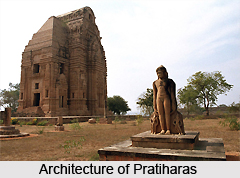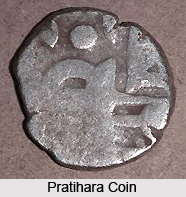 The Pala Pratihara domain initiated the supremacy of the feudal economy in northern India. During their reigns the trade and commerce of Northern India declined considerably. The decline of the money economy resulted in the growth of the landed grantees who were actually the feudal lords. In due course land became the principal source of income in the Pala Pratihara feudalism. After the downfall of the Pala Pratihara Empire, the condition of northern India was pretty chaotic. Northern India was disintegrated into petty political units under numerous dynasties. Most of these dynasties belonged the Rajput houses, who were involved in mutual fighting.
The Pala Pratihara domain initiated the supremacy of the feudal economy in northern India. During their reigns the trade and commerce of Northern India declined considerably. The decline of the money economy resulted in the growth of the landed grantees who were actually the feudal lords. In due course land became the principal source of income in the Pala Pratihara feudalism. After the downfall of the Pala Pratihara Empire, the condition of northern India was pretty chaotic. Northern India was disintegrated into petty political units under numerous dynasties. Most of these dynasties belonged the Rajput houses, who were involved in mutual fighting.
Civil Strife among Rajputs
The internal struggle in the Rajput House made the political condition even bitterer. The administrative and the economic consequences contributed to the spread of feudalism more intensely. Service grants of land were highly in practice during this period. Under the Rajput feudalism, Odisha became the most important region where the service grants were made in plenty. Comparatively Bengal had a lesser amount of service grants. Only some land grants to the Kaivartas were found in Bengal. In Assam and Bihar also this service grant of land was in vogue.
In the period of Rajput feudalism, service grants were associated with all the rights usually made to the grantees. The "Bhanja Copper Plate" of Khanjali, describes the system of allotment of land with usual rights in the Rajput feudalism. The Bhanjas granted lands to the military rulers. These military rulers were called "Mahasamantas" which in turn military services to the Bhanjas. The Ganga kings also made grants to the military chiefs called "Nayakas".
Administration of Ganga Dynasty
 By the 13th century the Ganga administration became completely feudal. In 1295 Narasimha Deva II granted villages to Kumara Mahapatra, a minister of the king. The minister Kumara Mahapatra then assigned the village to a Tambuli or betel seller and Tamraka or copper smith. The purpose of such a division was to make a self-sufficient village economy. The system of land grants prevalent in the Rajput feudalism shows that rulers paid their ministers in terms of land.
By the 13th century the Ganga administration became completely feudal. In 1295 Narasimha Deva II granted villages to Kumara Mahapatra, a minister of the king. The minister Kumara Mahapatra then assigned the village to a Tambuli or betel seller and Tamraka or copper smith. The purpose of such a division was to make a self-sufficient village economy. The system of land grants prevalent in the Rajput feudalism shows that rulers paid their ministers in terms of land.
Administration of Chandellas of Bundelkhand
The Chandellas of Bundelkhand made land grants to the civil and military officers. The Chandella kings granted villages with usual rights in order to have the military services when necessary. In contrast to the Chandellas, the Gahadavalas in U.P granted the whole villages to civil officials specially Brahmanas. The Brahmanas were acted as the purohits or the Thakkuras in the royal house. They were paid in terms of land by the kings.
The Chauhan land grants were mainly aimed for the maintenance of the royal family. The "Nadol grant" showed that12 villages were granted to the Rajkula in perpetuity with all the usual rights. These land grants were usually secular. The members of Rajkula, who were granted lands, also performed administrative tasks. These feudal chiefs acted as the vassals of the Chauhan kings. Not only the members of the royal family, non-members were also allotted land. But the no members were granted lands in lieu of their service to the king.
Parmaras Feudatories
The ruling Rajput dynasties of northern India assigned villages for secular services to vassals and officials. The assigned vassals and officers enjoyed usual feudal rights and revenues. They in turn offered homage to the suzerain, paid tribute, military and administrative services. The villagers were compelled to offer labor and provide for boarding and lodging of the feudal lords. The Chauhans and the Parmaras feudatories had to perform all the duties of state, civil, military and administrative services.
The literary and the epigraphic sources revealed that the important duty of a feudal vassal in the Rajput period was to offer military service to the king. The Palas and the Pratiharas also made all the grants in order to have military service. The vassals played an important part in politics and administration of the kingdom. They also played important role during the disputes for succession to the throne. The Samantas or the feudatories came to be known as the hereditary social class. Thus feudalism in Rajputs was somewhat different from the Pala Pratiharas. But the Rajput feudalism made the condition of northern India extremely worse.



















